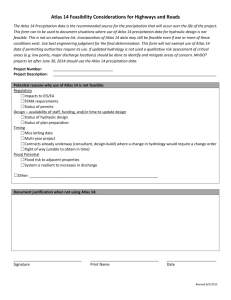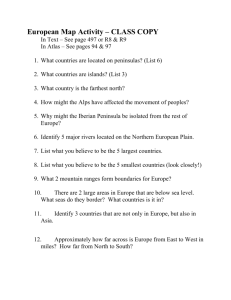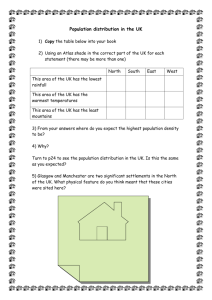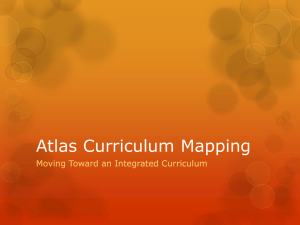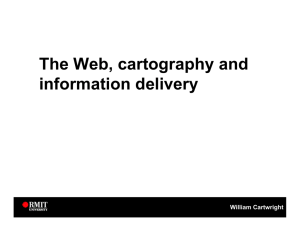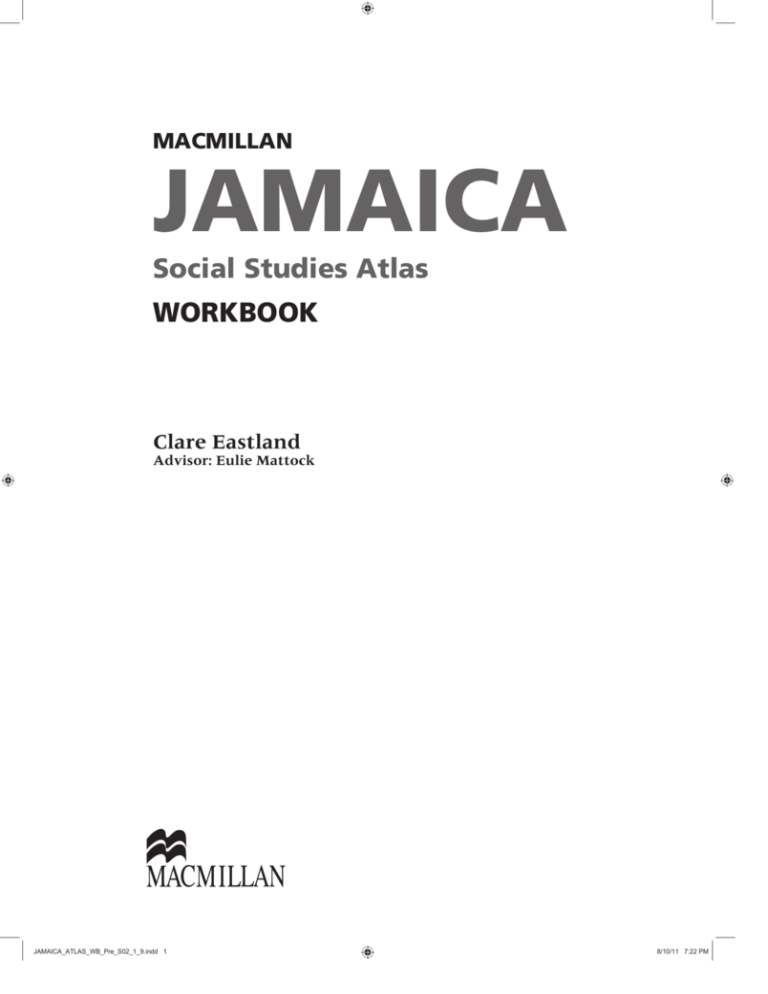
MACMILLAN
JAMAICA
Social Studies Atlas
WORKBOOK
Clare Eastland
Advisor: Eulie Mattock
JAMAICA_ATLAS_WB_Pre_S02_1_9.indd 1
8/10/11 7:22 PM
Macmillan Education
Between Towns Road, Oxford, OX4 3PP
A division of Macmillan Publishers Limited
Companies and representatives throughout the world
www.macmillan-caribbean.com
ISBN: 978-0-230-40278-2
Text © Clare Eastland 2011
Design and illustration © Macmillan Publishers Limited 2011
First published in 2011
All rights reserved; no part of this publication may be
reproduced, stored in a retrieval system, transmitted in any
form or by any means, electronic, mechanical, photocopying,
recording, or otherwise, without the prior written permission
of the publishers.
These materials may contain links for third party websites.
We have no control over, and are not responsible for, the contents of such third party websites.
Please use care when accessing them.
Designed by Tech Type
Typeset by E Clicks Enterprise, Malaysia
Illustrated by Kevin Baverstock and Peter Harper
Cover design by Cary Fielder at Clear 22
Cover photographs by (front) Alamy, Getty, Macmillan Publishers Ltd, (back) Getty
Printed and bound in Malaysia
2015 2014 2013 2012 2011
10 9 8 7 6 5 4 3 2 1
JAMAICA_ATLAS_WB_Pre_S02_1_9.indd 2
8/25/11 10:18 PM
Contents
1 Introduction 4
6 Our Caribbean neighbours 64
About the Macmillan Jamaica Social Studies Atlas 4
Using the Workbook glossary 5
Atlases and maps 6
Using the atlas contents 7
Using the atlas index 7
Types of maps 9
Caribbean countries and capitals 64
History and culture 68
Physical features 72
Climate and natural hazards 76
Resources of the Caribbean 78
Environment and conservation 82
Co-operation among Caribbean neighbours 84
End-of-section test 86
3 Map and globe skills 10
7 The world 87
Direction 10
Map grids 13
Latitude and longitude 14
Grid references and co-ordinates 17
Map symbols and keys 19
Altitude 23
Scale and distance 25
End-of-section test 31
Planet Earth in the solar system 87
Physical characteristics of the Earth 89
The Earth’s movement 93
Earth’s natural resources 96
Climate and climate regions 99
Life in countries in different climate zones 102
The global village 107
End-of-section test 109
4 Using diagrams, tables, graphs, charts,
text boxes and photographs 32
8 Get to know the continents and countries
of the world 110
Diagrams 32
Tables 33
Graphs and charts 34
Text boxes 39
Photographs 39
End-of-section test 41
North America 110
South America 111
Europe 112
Africa 112
Asia 114
Template map of Jamaica and direction of
finder 115
Template map of Caribbean 117
Template map of world 118
2 Using the atlas and Workbook 5
5 Jamaica 42
Location and physical features 42
Counties and parishes 44
History and culture 47
Climate and natural hazards 49
Natural resources 52
Economic activity including tourism 54
Trade and transport 56
Environment and conservation 59
Population 61
End-of-section test 63
JAMAICA_ATLAS_WB_Pre_S02_1_9.indd 3
Glossary 119–120
Answers 121–128
8/10/11 7:22 PM
SECTION 1
INTRODUCTION
This Macmillan Jamaica Social Studies Atlas Workbook is intended mainly for students at upper
primary, studying for GSAT examinations. However, most of the activities will also be useful
for students doing map or atlas work in Social Studies at lower secondary.
The Workbook is best used with the Macmillan Jamaica Social Studies Atlas, and page references
in the text refer to the Macmillan atlas maps and other features. These references are styled as
‘Atlas xx ’. However, the Workbook has been carefully designed so that most of the activities
will work equally well with other suitable atlases.
The Workbook consists of eight sections. Section 2 helps students to use both their atlas
and this Workbook. Sections 3 and 4 cover basic map and atlas skills and take students well
beyond the level needed for the GSAT Social Studies examination. Sections 5 to 7 cover much
of the Social Studies content for the syllabus Grades 4 to 6 and provide interesting alternative
activities to any course textbook. Section 5 covers Grade 4 material on Jamaica, Section 6
covers Grade 5 material on the Caribbean and Section 7 covers Grade 6 material on the world.
Each main section has a short end-of-section test of multiple choice questions about the
material in that section, in the GSAT style. Section 8 provides template maps of Jamaica, the
Caribbean region and the world to enable teachers to set other map exercises and students to
draw their own maps.
Throughout the book Extension Activities are provided – these are more open-ended and can
be used to stretch more able students or those who finish work quickly.
There is a glossary of atlas and map terms. Answers are provided at the back of the Workbook,
pages 121 to 128.
About the Macmillan Jamaica Social Studies Atlas
The Macmillan Jamaica Social Studies Atlas was first published in 2010. It is suitable for both
upper primary and lower secondary students. It has sections on understanding maps, world
maps and maps of all the continents. It also has a world themes section, particularly useful
at Grade 6. There is a 14-page section on Caribbean themes and a large section providing
detailed maps of the individual Caribbean territories. There is also a section of 26 pages of
detailed Jamaican maps covering a wide range of topics, including a large 4-page map of
Jamaica.
Throughout the atlas there are photographs, tables, graphs, diagrams, fact files and text boxes
to aid learning.
4
JAMAICA_ATLAS_WB_Pre_S02_1_9.indd 4
8/10/11 7:22 PM
SECTION 2
USING THE ATLAS AND WORKBOOK
Using the Workbook glossary
This Workbook has a glossary at the back (page 119) to help you learn words used in Social Studies to
do with atlases, maps and map skills. It gives the meanings of the words. As you read through this book
you will find some words in bold print. These are found in the glossary. The glossary lists the words in
alphabetical order.
1.
Write the following words in the order they appear in the glossary:
scale, hemisphere, planet, grid, compass, pie chart
2.
There is a name for this type of order. What do we call it?
3.
What is the meaning of the following words in the glossary?
boundary
continent
direction
Equator
What do you notice about the words above?
4.
The word search below contains 10 words from the glossary.
Find the words and make sure you know their meanings.
A
F
G
L
O
B
E
T
T
I
K
E
Y
E
S
Y
Q
D
U
S
G
H
I
E
C
I
U
S
S
L
J
K
M
D
A
U
A
W
X
A
P
O
P
U
L
A
T
I
O
N
L
P
O
S
E
H
O
Z
R
D
A
G
R
W
F
T
R
A
D
E
N
Q
T
C
A
P
I
T
A
L
Extension Activity
As you use this book, write your own word list
in alphabetical order of the new words you have
learnt.
5
JAMAICA_ATLAS_WB_Pre_S02_1_9.indd 5
8/10/11 7:22 PM
SECTION 2 USING THE ATLAS AND WORKBOOK
Atlases and maps
What is an atlas?
An atlas is a book of maps.
Fill in the blanks below. (See What is an Atlas? on page 4 of the Atlas.)
of maps. Usually it contains maps showing the whole w
An atlas is a c
Atlas maps usually show l
areas of the world, such as c
or regions. A
region.
Caribbean atlas contains world maps but also many maps of the C
What is a map?
A map or plan is a picture of a place drawn from directly above. A map shows a large area such as a village,
county or the world. A plan usually shows a room, building or small area of land.
Usually we look at objects or places from the side. When we look at them from above they look very different.
Picture
Plan
exercise
book
backpack
pencil
Extension Activity
ruler
Put three objects on the top of your
desk. Now draw a plan to show this.
Look at the picture and plan shown above. Draw plans of the following objects beneath the pictures.
When we draw a plan or map we cannot draw it the same size as the real place – there would not be enough
room on the paper. So we draw it to scale. You will learn more about scale on page 25 of this Workbook.
Extension Activity
Try drawing plans of different objects.
Some will be easier than others.
6
JAMAICA_ATLAS_WB_Pre_S02_1_9.indd 6
8/10/11 7:22 PM
SECTION 2 USING THE ATLAS AND WORKBOOK
Using the atlas contents
The contents page of an atlas lists the sections and maps in the atlas. Find the contents of your atlas (in the
Macmillan Atlas go to the inside front cover). It is usually right at the beginning. You will see that the maps
are grouped in sections. Each map is listed with its page number.
1.
Name two sections of maps in the atlas.
2.
Name two different map pages in the Caribbean section and then find them.
3.
Name two different maps in the World section and then find them.
4.
What map is found on Atlas page 32 ?
5.
What number pages have maps of Jamaica?
6.
What number pages have maps of Europe?
Extension Activity
Make your own atlas – a collection of maps from
newspapers, magazines, the internet or drawn
yourself. Give your atlas a contents list.
grid
reference
page
number
Using the atlas index
Most atlases have an index of places at the back. The index helps
you to locate (find) places on the maps in the atlas. It lists many of
the important places shown in the atlas in alphabetical order.
Find the index in your atlas (Atlas 95 ). Read the index abbreviations
at the top of the index. The column on the left shows the place. The
column next to it on the right shows the page number and grid
reference. (See page 13 for more about grid references.)
Find Kingston in the atlas index. An extract from the Atlas index is
shown here. ‘Kingston’ is in bold print because it is the capital of
Jamaica and this is a Caribbean atlas. We call each place in the list an
‘entry’. Kingston is an entry.
3
7
6
9
8
7
4
7
9
13
3
9
7
9
8
7
7
Khartoum, Sudan
Kiev, Ukraine
Kigali, Rwanda
Kilmarnoch, WD, Jamaica
Kings Valley, WD, Jamaica
Kingshill, US Virgin Islands
Kingston Harbour, Jamaica
Kingston, KN, Jamaica
Kingstown, St Vincents and the
Grenadines
Kingsvale, HR, Jamaica
Kingsweston, AW, Jamaica
Kinloss, TY, Jamaica
Kinshasa, Democratic Rep of the
Congo
Kiribati, Oceania, Australasia
Kishinev, Moldova
80
79
80
27
26
53
23
28
C7
C10
E7
C3
B2
E2
C4
D7
60
26
28
27
C1
B2
C7
B4
80 E5
82 B3
79 D9
7
JAMAICA_ATLAS_WB_Pre_S02_1_9.indd 7
8/10/11 7:22 PM
SECTION 2 USING THE ATLAS AND WORKBOOK
Look at the index extract on page 7. Next to Kingston you can see the word ‘Jamaica’ in italics. The name in
italics next to each entry is the country, region or continent where the place is found.
1.
What is the page number for Kingston?
2.
What is the grid reference for Kingston?
Use the index of your atlas to answer:
3.
What is the first place or entry beginning with B?
What is its page and grid reference?
4.
Arrange the following places in alphabetical order, as they are shown in the index:
St Lucia, Grenada, Martinique, St John’s, Haiti, Georgetown
5.
6.
Look up Trinidad. Where is it located? (look at the word next to it in italics)
What kind of place is this?
Which page is it on?
Find Georgetown. Where is it located?
Which page is it on?
What kind of place is this?
7.
Which page is it on?
Find Ghana. Where is it located?
What kind of place is this?
8.
Find one entry which is a town in the Caribbean.
Which page is it on?
Where is it located?
What kind of place is this?
Now turn to the map pages for each of your answers to 1–8 above. Can you find the places on the maps?
9.
Use the index to find each of the following capital cities. Write down which country they are capital of.
Port of Spain
Havana
Bridgetown
Accra
Wellington
Tokyo
Moscow
Use the index to help you find each city on a map.
10. Use the index to find two towns and two countries beginning with the letter C:
towns
countries
Find them on the maps.
Extension Activity
Set a quiz of six questions for a partner using
the index of your atlas. Make sure you know
the answers.
8
JAMAICA_ATLAS_WB_Pre_S02_1_9.indd 8
8/10/11 7:22 PM
SECTION 2 USING THE ATLAS AND WORKBOOK
Types of maps
There are different types of maps in the atlas. Read the section on Types of Map (Atlas 4 ).
There are topographic maps, which show information about the physical and human environment. Physical
maps show physical features such as mountains and rivers. Political or administrative maps show countries,
regions, counties, cities and towns.
There are also thematic maps. They show specific information about one topic, such as history, rainfall,
population or tourism.
1.
Look at the different types of maps in the atlas. Give an example of:
Name of map
Page
a) a topographical map (physical and political)
b) a physical map
c) a political map
d) a thematic map of the Caribbean
e) a thematic map of Jamaica
2.
What type of map would you look at to find:
a) mountains, rivers, roads, major cities?
b) mountains, valleys, rivers and swamps in the Caribbean?
c) Jamaica’s counties, parishes, towns and cities?
d) rainfall?
Each map in an atlas has a title. This tells you the type of map and the country or region it shows.
3.
What is the title of the map on Atlas page 40 ?
4.
On what page is the map with the title Caribbean Climate?
5.
Name three types of thematic map in the Caribbean section of your atlas.
Extension Activity
Invent an island of your own. Give it a name.
Draw a physical map of your island. Draw a
political map of your island. Choose one theme
and draw a thematic map of your island. Give
each map a title.
To find information or places you can now use the contents, index and titles of maps to help you.
9
JAMAICA_ATLAS_WB_Pre_S02_1_9.indd 9
8/10/11 7:22 PM
SECTION 3
MAP AND GLOBE SKILLS
Direction
We use a compass to find direction. The
needle always points towards the Earth’s
magnetic North. You turn the compass to
line the needle up with the line pointing to
N. Then you know in which direction you
are facing. A compass is shown here.
G4
•
define and use correctly:
cardinal points
•
describe Jamaica’s location
in relation to other
Caribbean territories using
the cardinal points
•
state the direction of one
territory from another by
using cardinal points
N
Most maps are drawn with North at the
top of the page. They often also have a
compass rose or North point to remind you.
A compass rose is a symbol on the map to
show direction.
1.
G5
Look through the atlas maps and find the compass rose or North point. Draw it here:
Cardinal points
There are four main directions, called cardinal points. They help us to describe the position of places in
relation to each other.
2.
Read page 2 in the Macmillan Atlas. What are the four cardinal points?
3.
Write the names of the cardinal points correctly
on the diagram below (you can use the picture
of the compass to help you).
4.
Now write just the initials on this diagram.
10
JAMAICA_ATLAS_WB_S03_10_31.indd 10
8/10/11 7:33 PM
SECTION 3 MAP AND GLOBE SKILLS
Intermediate points
Look at the compass again. You can see there are more than four points shown. The other points are called
intermediate points. Each is halfway between two cardinal points.
5.
Write the full names of the intermediate points on
the diagram.
1
1
Now write the initials of all the missing direction
points on the diagram.
1
:
1
(
6
7.
6.
6
6
6(
Complete the sentences.
Extension Activity
a) West is halfway between North and
b) South-east is halfway between South and
c)
is halfway between North and West
d) South-west is
between South and West
Go out into the playground. Each
student can be a human compass.
The Sun rises in the East. Stand with
your arms outstretched, your right
hand pointing towards where the
Sun rises.
e) What direction is between E and S?
In which direction is your left hand
pointing?
f) What direction is between E and N?
In which direction are you facing?
Draw a chalk compass rose on the
ground to show the cardinal points.
8.
What direction is shown by each arrow? Write the initials.
a)
N
b)
N
c)
N
d)
N
11
JAMAICA_ATLAS_WB_S03_10_31.indd 11
8/10/11 7:33 PM

